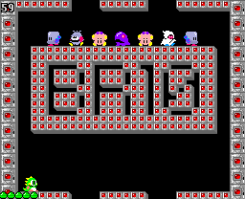A friend of mine just tweeted about this Bubble bobble hack of mine being “a true act of love and devotion”. I’m flattered, and, since we’re talking about a 2D game, flattened too. HA HA!
Thinking about it, there’s some kind of religious vibe in it. In this months I completed every Bubble Bobble game ever made in every conceivable game mode, looking for levels not present in the coin-op. Yeah, also the one on FM-Towns with female dragons. Oh, and the Korean Zemina clones.
I took almost a thousand of screenshots of every level. I classified bonuses and behaviors for non coin-op versions, finding more questions than answers (“Why hitting an enemy with a thunder should create a snowman?”). I wrote emails to programmers I didn’t know at all begging for custom hacking tools.
(And believe me, only faith can guide you thru’ the 128 levels of the Game Boy Color version, which have been organized in branches in a way which pretends to appear mysterious, but it’s only mindfuckingly bad, actually).
Studying the Bubble instead of the Book? Well, in a game design theory context, Bubble Bobble IS a holy text. And, as a game designer, I feel renewed and inspired each time I lose myself in that pixel grid. So we don’t have Gospels, but Levels to study. Let’s have a look to a level which is present in every Bubble Bobble version (apart from the GBC black sheep one), but with interesting changes.
ARC RND 59 (1986) The original one. Lots of different enemies with different movement patterns. It’s hard to find a safe pattern, since the low overall predictability of enemy troops. The playable area is mostly split between the upper and lower part of the screen, with flying enemies quickly passingh thru’ the holes – so you need great timing if you plan the classic leap of faith into the floorhole. Yet the kamikaze-style is highly rewarding in terms of adrenaline. To make it even frantic, this is the level with the fastest bubble speed value of the whole game. Enemies take 20 seconds to free themselves from a bubble: this means that you trap them, the bubbles quickly float away and typically comes back to you in time to release an angry enemy. Great level of the “arena” kind: minimal platform layout design, focus on fighting!
NES RND 59 (1987) none of the home versions were designed by Fukio Mitsuji – other designers had to tweak the original level design in order to fulfill new guidelines and technical requirements. The enemy setup is a little less demanding – 3 enemy types instead of 5 mean a little more readability. And with the NES gfx flickering you do need more readability. (there’s a third Monsta you can’t see because of that)
SMS RND 59 (1988) Sega Master System is my favourite home version: it’s looong, full of secret stuff. It doesn’t have the tight vibe of the coin-op, but since it’s twice as long (200 rounds) it’s good to have the pace tuned down a little. RND 59 here is pretty much the same as its NES counterpart, but it plays better because the bubble mechanics work better on SMS.
GB RND 60 (1990) As you may know, the Game Boy Bubble Bobble version plays quite differently even retaining the same game rules of the coin-op, and that’s what captivates me. This Game Boy Difference happened because a) Four years passed since the original BB coin-op b) playing Bubble Bobble with scrolling is a freakin’ contradictio in adiecto. That led to a serious rethinking of level and enemy layouts. Take this one! Invaders are predictable, they fall instead of flying, it’s most unlikely to hit them while falling thru’ the floorholes. And there’s only 4 of them too! This level would have been super easy on the coin-op, not suited for the lv. 60 slot, but it works fine on the Game Boy, and at least it rebalances the weird scrolling thing.
GG RND 59 (1994) For curiosity’s sake, the Game Gear version, released in the states 8 years after the original BB! It stays true to the SMS version, therefore it chooses not to have scrolling… but to shrink level size instead! It feels very cute (form-wise) and very claustrophobic (function-wise) at the same time. Still, it retains most of the SMS playability, which is a sort of readability miracle to my eyes: it’s playable albeit crammed because you get the whole situation without even moving your eyeballs.
Of course there’s another BIG semantic difference between the 4 levels: those damn mysterious writings! BR10, FA10, BV50, FR30. WTF? I tought that those writings changed from system to system as a form of in-joke about different program instructions fed to the different CPUs, but programmers at my workplace told me that it’s most unlikely so. Yet, since everything in Bubble Bobble has some kind of meaning, we shall look for some other interpretation. I’m inclined to think it’s some Japanese wordplay, especially of the kind called Goroawase (pronouncing numbers using different reading conventions). Unfortunately, I do not speak Japanese, so I can only come up with random silly interpretations! Here:
BR10 can be read as BURU Ten which can mean “Bull Exibihition”. Makes sense, since there’s a lot of different enemies in exibihition. Ok, It doesn’t make sense. Or is it the katakana reading (BURUTO) for Blut, German word for Blood? It’s a bloody hard level, after all, so… So is anybody Japanese, out there? Help!
(My girl said those are UK car number license plates. Kinda kills BB exoteric poetics, and it scares me, since usually she’s right).
Ah, one more thing: all these home levels were rejected and you won’t find them in my hack. Aw, COME ON – their minimal changes upon the original one are clever, but TOO minimal:)





![Bubble Bobble (U) [!]000](https://lostcave.wordpress.com/wp-content/uploads/2012/08/bubble-bobble-u-000.png?w=584)